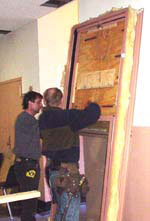A New Outlook for TC
Out with the old and in with the new windows.
A window replacement project at TC is the final phase in the sealing of the "skin" of some of the buildings. The project will help to end the water leaks and provide better temperature stability during inclement weather. About 1,000 new windows will be installed.
The first phase of the $1.5 million window replacement project began in March in Horace Mann and will continue through Grace Dodge this spring. Window replacement in other buildings will begin in 2002. "Although TC isn't a landmarked building, it still considered historic and landmarkable," said Vincent Del Bagno, Director of Capital Projects.
During this project, we wanted to be respectful of the history of the Morningside Heights community and its aesthetic desires."
Keeping the building looking as authentic as possible is a difficult task. Del Bagno and Israel Berger and Associates, a window consulting firm, worked with the New York City Landmarks Conservancy who reviewed and approved the project. The installation of the new slate roof and the copperwork reproductions were also part of Del Bagno's efforts to keep the building historically accurate.
Even though many of the windows seem to be similar, each window is slightly different, said Del Bagno. The builders in the early 1900s made an individual window for each individual space. Since the builders didn't deal with manufactured windows, each one has slightly different dimensions. Today's windows are all manufactured in standard sizes. Each new window will be custom made to fit each space.
The large panes of glass in the original windows provide as much light as possible. Del Bagno wanted to preserve this. The new windows have the same large panes of glass to maintain the architect's original intentions.
Although tinted glass was an option, Del Bagno said that it would change the look of the building. Even with the various shades of tinting, he opted not to tint the glass because it didn't keep with the historic nature of the building.
At first, Del Bagno wanted to try to repair the existing windows. However, the deterioration of the wood around the windows was beyond repair. The next best option seemed to be wood framed windows, but he found that aluminum windows cost half as much and require less maintenance.
In order to match the new aluminum windows to the sandstone of the building, Del Bagno used a paint chip and computer technology where a computer analyzes the composition of the paint on the chip to determine what color will match the building. Then, the windows were custom ordered in the appropriate sizes and color.
"Since the windows are a significant component to the face of the building," said Del Bagno, "it took research, leg work and investigation to be responsive to the needs of the building within the cost constraints of this project."
Published Tuesday, Sep. 18, 2001

